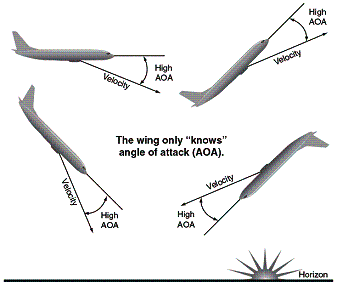Understanding aerodynamic angles (Pitch, Angle of Attack, and Flight Path Angle) is crucial for pilots, especially in UPRT. Mastering these angles prevents stalls and ensures safer flights, fostering a safety-oriented aviation community.
As pilots, whether we fly for a living or enjoy weekend adventures in the sky, it's crucial to stay connected with fundamental aerodynamic concepts. These concepts may have been introduced during our flight training, but they can sometimes fade into the background over time. In this discussion, let's refresh our knowledge of three critical angles that are essential for pilots to comprehend, especially in the context of Upset Prevention & Recovery Training (UPRT).

Defining the Critical Angles
Angle of Attack (AoA)
The Angle of Attack is the angle between the chord of an airfoil (wing) and the relative wind. It can be roughly approximated as the difference between the pitch angle (up or down attitude of the nose or wing) and the flight path angle (the angle between the flight path vector and the horizon). AoA determines whether the aircraft's aerodynamic surfaces are stalled or not, meaning it affects the lift and control of the aircraft.
Flight Path Angle
The Flight Path Angle refers to the angle between the flight path vector (the direction the aircraft is moving) and the horizon. It is also equivalent to the climb or descent angle, giving us a clear understanding of the aircraft's vertical movement in relation to the earth's surface.
Pitch Attitude or Pitch Angle
Pitch Attitude is the angle between the longitudinal axis of the airplane and the horizon. It is typically displayed on the attitude indicator or artificial horizon by the aircraft symbol, showing the aircraft's nose-up or nose-down position.
Simplifying the Concepts
Explaining these concepts to someone unfamiliar with aviation jargon can be challenging, but with a little patience and a practical example, it becomes easier to grasp. Let's take the example of explaining these angles to your great grandmother, who prefers driving from New York to Los Angeles rather than taking a flight with you. Visual aids, like a model airplane, can be helpful.
Pitch - Imagine the "pitch" as the up or down attitude of the airplane's nose or wing. It's like pointing the airplane in a particular direction.
Pitch Angle or Pitch Attitude - This angle is the difference between the pitch and the horizon. Think of it as the angle between the airplane's current attitude and the flat horizon.
Flight Path - The "flight path" is simply the direction in which the airplane is going.
Flight Path Angle - This angle is the difference between the flight path and the horizon. It gives you an idea of whether the airplane is climbing or descending concerning the earth's surface.
Angle of Attack - The "angle of attack" is the difference between the pitch (where the airplane is pointed) and the flight path (where the airplane is going). The confusion sometimes arises because we mostly practice stalls in level flight, which is a slow deceleration situation at 1G. In this context, a stall always occurs at the same speed and with a relatively consistent pitch attitude relative to the horizon. However, the angle of attack is different and depends on the relative wind, which is the airflow opposite to the flight path. This airflow is invisible without instrumentation or avionic references.

Critical Angle of Attack and Safety
Understanding the critical angle of attack is essential, as it marks the point where the airflow separates from the wing, causing a loss of lift. This can happen in any attitude and even at different airspeeds, especially if the aircraft experiences more or less than 1G of acceleration. Surprisingly, an airplane can stall even with the nose below the horizon, a scenario many pilots have never encountered.
The good news is that regardless of the pitch attitude, reducing the angle of attack is possible by lowering the nose of the aircraft (moving the yoke or stick forward). Mastering these three angles and their relationships is vital for responding correctly to prevent a stall, which is the most common outcome of unexpected airplane upsets.
Remember, maintaining a solid understanding of aerodynamic principles is a crucial component of flight safety. Whether you are a seasoned aviator or a trainee, discussing and reviewing these concepts helps enhance your skills and ensures safer flights each day. Your commitment to ongoing learning contributes to a safer and more confident aviation community.
